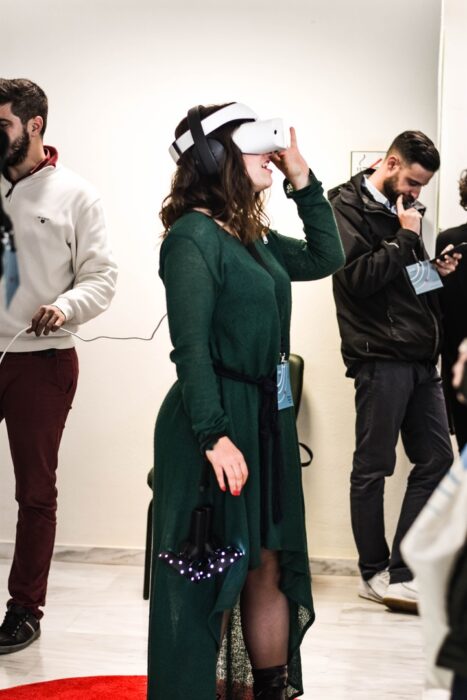
The study “A Field Analysis of Immersive Technologies and Their Impact on Journalism: Technologist Perspectives on the Potential Transformation of the Journalistic Field” by Shangyuan Wu from National University of Singapore used Pierre Bourdieu’s field theory and interviews to examine the potential of immersive technologies in journalism.
Immersive journalism has been has grown in the past decade and is a recent phenomenon, with the term used interchangeably with VR journalism. Nonny de la Peña, in her landmark study, defined it as news that is produced “in a form in which people can gain first-person experiences of the events or situation described in news stories”.
This study focuses on a gap in the previous research: no studies have focused on the potential impact of VR firms in transforming the journalistic field. 12 technologists from the World’s leading 11 companies were interviewed here to gain an understanding on the topic.
The other prism through which the topic is looked at is Bourdieu’s field theory. He defines (2005) field as a “independent social space and field of forces, which agents struggle to either transform or preserve”.
Structure and agency are opposing concepts within the field that must coexist, and doxa is the system of internal rules and principles followed by agents in the field. Habitus is the accumulated knowledge and experience of the agents. The third key dimension is capital, “the material and non-material asset that the given field possesses to distinguish itself from other fields in terms of its value and role”, as defined by Wang (2018).
This study conceptualizes the technology firms as “new entrants” that integrate with the journalism field’s doxa, bringing their own logics with them. This sort of conceptualizing is familiar from other studies in the transformation of journalism, such as Perreault and Stanfield (2019) on mobile journalists vs. traditional journalists, or Tandoc (2018) on entertainment websites foray into investigative journalism.
The impact on principles (doxa) is that the essence of journalism remains unchanged. The participants agreed that journalism should tell unbiased truths about society, and VR and immersive technologies are a tool to help with depth in that. Some participants discussed shifting principles, first that journalism needs to leverage on different formats and platforms for news. Second, the focus is on the user. Third, it changes how journalists “see” the story – the technologies force journalists to see things through someone else’s eyes.
When it comes to habitus, the participants again noted three elements. First, now there is a consideration on whether to use immersive technologies in stories. Emotional stories work best here. Second, journalists need the environments and experiences that are created, and what sort of content to capture. Third, there is a need to allocate enough time, budget and resources for these immersive stories.
There is also an impact on skills (capital). Journalists need to hone their skill in seeing what scenes work in 3D, and to visualize differently. There is also a need to understand the so called “game mechanics” – how the user might interact with the story that is now less linear. Participants suggest that journalists should not necessarily learn the technologies themselves, but work in multidisciplinary teams.
The “new entrants” – the technology companies – faced obstacles entering the field. A key deterrent was the amount of resources needed for immersive stories, as the time required makes them more of “special features” rather than part of the news cycle.
The outreach was also an issue, as VR was not in everyone’s homes. Therefore, the return for investments seemed small. Measuring the success in news is also hard. The participants suspect that news organizations might invest on it as a matter of winning awards, rather than committing generally on it.
A related challenge to the outreach is the technology itself, as audiences might need to take many steps to get the information. This might require not just the technology but downloading apps and such. It is also the technology firms that own the framework.
Nevertheless, the participants estimated that immersive journalism will break within 5 to 10 years, with a key component being AR, Augmented Reality, which is the most accessible.
The findings suggest, in part, a tug of war with the internal forces of journalism and the external forces seeking to change it. Immersive technologies have manages to occupy a position in well-established and funded news organizations such as BBC or The New York Times. At the same time, the field is fighting to preserve its own principles. Individual agents may also be resistant.
Technology firms seek to appeal to journalists’ desire to better tell the truth, being a tool that journalists can use to better their craft. The companies, on the other hand, can influence other parts of society so that immersive technologies become a “language of the generation” and audiences start demanding agency also in news. The firms are already part of the journalistic field and they have ample resources to drive change.
The article “A Field Analysis of Immersive Technologies and Their Impact on Journalism: Technologist Perspectives on the Potential Transformation of the Journalistic Field” by Shangyuan Wu is in Journalism Studies. (free abstract).
Picture: Untitled by Sophia Sideri.
License Unpslash.